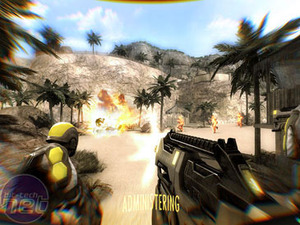
Keeping it real
The first question on any designer's or writer's mind is usually to do with how they want players to experience the game. The obvious thing to say is that FPS games work best when the designer and writer wants the player to view the world as if they were actually there, immersing them into the fictionalised environment.The quickest and easiest way to do this is plunge the player into a first-person perspective, which is critical to the genre, and then keep them there, looking through the eyes of the character and experiencing the action as they would.
However, this presents problems all of its own as the action sometimes can't be easily conveyed in a first person perspective – which is why some games, particularly console games, will often break from the first person perspective to show a third person view of the characters actions, like when Jackie Escatado from The Darkness uses items in the world or interacts with other characters. Breaking from the first-person viewpoint can often disorient players or force them to detach from the idea that they are the in-game character, which riddles the idea of a story cutscene with flaws.

Cutscenes that break away from the first person perspective can force players to disconnect from an otherwise good story.
It's simple enough to understand – players get so used to viewing the game from a first-person viewpoint that when they switch to a third-person view it may feel like they are actually a different character who is watching the character they had just been playing.
It was an issue that presented itself early in the design and writing stages of Haze and Rob Yescombe was mindful that sometimes the story has to be adapted to fit the viewpoint;
"We’re staying in first person for all of Haze – narrative scenes and all. We figured that there’s nothing too difficult about telling a story in first-person as long as you write one that’s fitting for that style. Hell, you experience the story of your life in first person, so how hard could it be? ‘Story of your life’. God that sounds ridiculous. Make sure you put ‘Said in Hilarious Way’ next to that."
He told us, hilariously.


Both Crysis (left) and Haze (right) have decided to stay in the first-person perspective throughout the whole game.
For Crytek it was a similarly early choice to use a constant first-person viewpoint for Crysis, a choice that was prompted by the way the designers wanted to tell the story;
“A decision was made very early in the project to utilize first person perspective throughout the entire game. There are a number of cinematic cutscenes in Crysis where we briefly take control in order to advance the story, but the player never leaves the eyes of the hero. Our goal has always been to keep player immersed in the game world and giving the player a consistent point of view is an important part of that... In terms of storytelling, the first-person perspective provides us greater opportunities for immersion because it brings the player closer to the action and, therefore, the story.”
It isn't always as easy as that though and the choice of whether to stay in first-person for the entire game and when to move to third-person if needed often requires a few concessions in terms of game narration.
For example, while it's easy to tell that Gordon Freeman is being dragged away by grunts from the way his viewpoint is angled in one scene of Half-Life, it isn't so easy to tell what's happening at first when, in Prey, Tommy's viewpoint is flooded with brown muck.
Have his eyes just been liquidated? No, he's just been sick because of the disorientation of zero gravity.
In this scene at the start of 3D Realms' Prey we're only really able to tell what has happened because Tommy speaks aloud, giving a point of context through which players can decipher the on-screen action. Moments like these, when characters played through the first person talk without player control can be equally problematic for developers, so how do writers approach such issues?

MSI MPG Velox 100R Chassis Review
October 14 2021 | 15:04











Want to comment? Please log in.